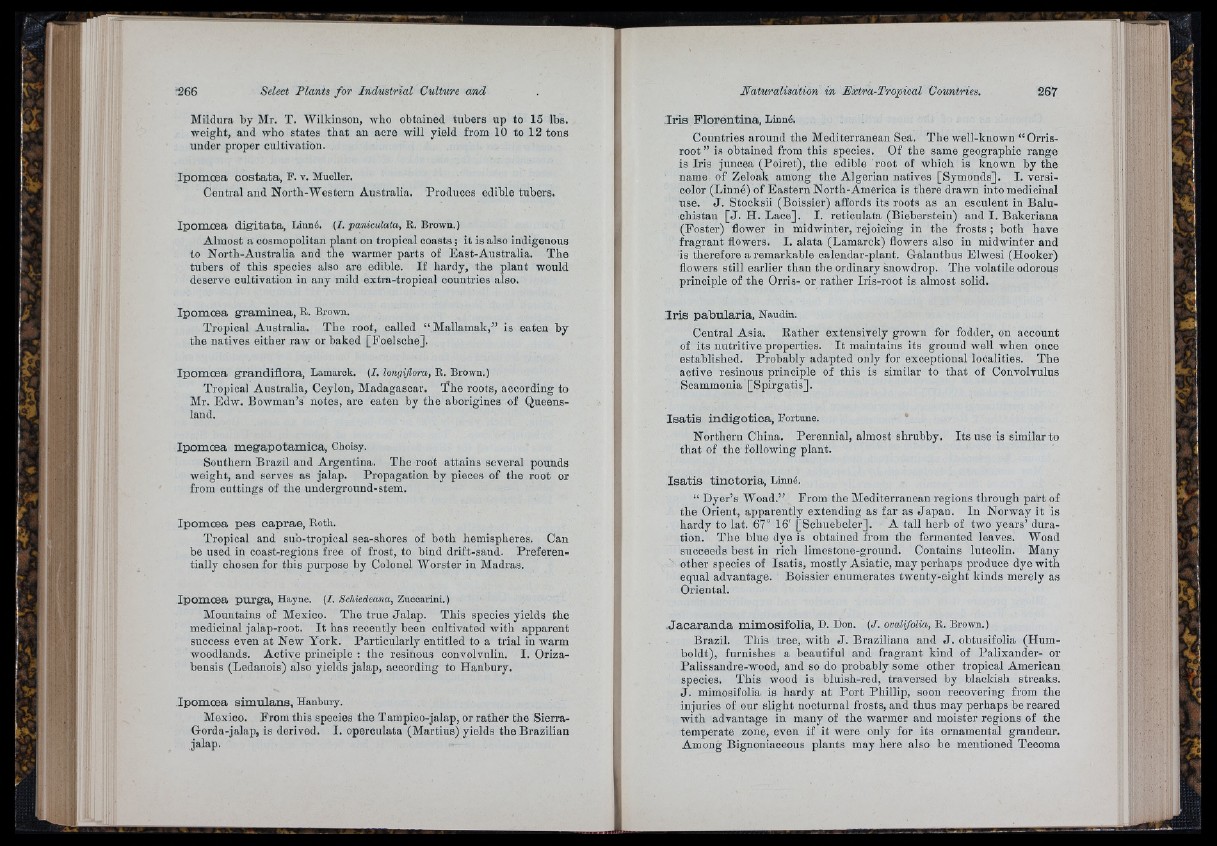
Select Plants fo r Industrial Culture and
Mildura by Mr. T. Wilkinson, who obtained tubers np to 15 lbs.
weight, and who states th a t an acre will yield from 10 to 12 tons
under proper cultivation.
Ip om oe a c o s ta ta , P. v. Mueller.
Central and North-Western Australia. Produces edible tubers.
Ip om oe a d ig ita ta , Linné. (/. paniculata, R. Brown. )
Almost a cosmopolitan plant on tropical coasts ; it is also indigenous
to North-Australia and the warmer parts of East-Australia. The
tubers of this species also are edible. I f hardy, the plant would
deserve cultivation in any mild extra-tropical countries a so.
I r i s F io r e n tin a , Linné.
Countries around the Mediterranean Sea, The well-known “ Orris-
root ” is obtained from this species. Of the same geographic range
is Iris juncea (Poiret), the edible root of which is known by the
name of Zeloak among the Algerian natives [Symonds]. I. versicolor
(Linné) of Eastern North-America is there drawn into medicinal
use. J . Stocksii (Boissier) affords its roots as an esculent in Baluchistan
[ J . H. Lace]. I. reticulata (Bieberstein) and I . Bakeriana
(Foster) flower in midwinter, rejoicing in the frosts ; both have
fragrant flowers. I. alata (Lamarck) flowers also in midwinter and
is therefore a remarkable calendar-plant. Galanthus Elwesi (Hooker)
flowers still earlier than the ordinary snowdrop. The volatile odorous
principle of the Orris- or rather Iris-root is almost solid.
Ip om oe a g ram ín e a , R. Brown.
Tropical Australia. The root, called “ Mallamak,” is eaten by
the natives either raw or baked [Foelsche].
Ip om oe a g ra n d iflo ra , Lamarck. (I. longiflora, R. Brown.)
Tropical Australia, Ceylon, Madagascar. The roots, according to
Mr. Edw. Bowman’s notes, are eaten by the aborigines of Queensland.
Ip om oe a m e g a p o tam ic a , Choisy.
Southern Brazil and Argentina. The root attains several pounds
weight, and serves as jalap. Propagation by pieces of the root or
from cuttings of the imderground-stem.
Ip om oe a p e s c a p ra e , Roth.
Tropical and sub-tropioal sea-shores of both hemispheres. Can
be used in coast-regions free of frost, to bind drift-sand. Preferentially
chosen for this purpose by Colonel Worster in Madras.
Ip om oe a p u rg a , Hayne. {I. Schiedeana, Zuccarini.)
Mountains of Mexico. The true Ja lap . This species yields the
medicinal jalap-root. I t has recently been cultivated with apparent
success even a t New York. Partioularly entitled to a trial in warm
woodlands. Active principle : the resinous convoi vnlin. I. Oriza-
hensis (Ledanois) also yields jalap, according to Hanbury.
Ip om oe a s im u la n s , Hanbury.
Mexico. From this species the Tam pico-jalap, or rather the Sierra-
Gorda-jalap, is derived. I. operculata (Martins) yields the Brazilian
jalap.
I r i s p a b u la r ia , Naudin.
Central Asia. Rather extensively grown for fodder, on account
of its nutritive properties. I t maintains its ground well when once
established. Probably adapted only for exceptional localities. The
active resinous principle of this is similar to that of ConvolTulus
Soammonia [Spirgatis].
I s a t i s in d ig o tic a , Fortune.
Northern China. Perennial, almost shrubby. Its use is similar to
th a t of the following plant.
I s a t is tin o to r ia , Linné.
“ Dyer’s Woad.” From the Mediterranean regions through part of
the Orient, apparently extending as far as Japan. In Norway it is
hardy to lat. 67° 16' [Schuebeler]. A tall herb of two years’ duration.
T h e blue dye is obtained from the fermented leaves. Woad
succeeds best in rich limestone-gronnd. Contains luteolin. Many
other species of Isatis, mostly Asiatic, may perhaps produce dye with
equal advantage. Boissier enumerates twenty-eight kinds merely as
Oriental.
J a c a r a n d a m im o s ifo lia , D. Don. (J. ovalifolia, R. Brown.)
Brazil. 'This tree, with J . Braziliana and J . obtusifolia (Humboldt),
furnishes a beautiful and fragrant kind of Palixander- or
Palissandre-wood, and so do probably some other tropical American
species. 'This wood is bluish-red, traversed by blackish streaks.
J . mimosifolia is hardy at P o rt Phillip, soon recovering from the
injuries of our slight nocturnal frosts, and thus may perhaps be reared
with advantage in many of the warmer and moister regions of the
temperate zone, even if it were only for its ornamental grandeur.
Among Bignoniaceous plants may here also be mentioned Tecoma